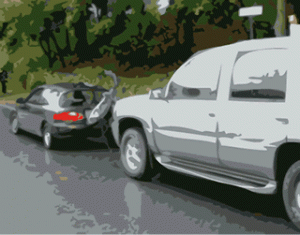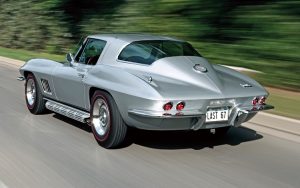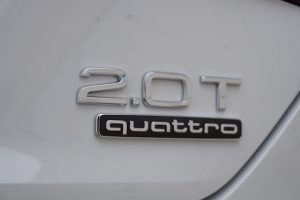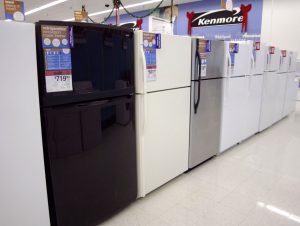The Celebration of Diversity is a non-stop party, except when it comes to cars – which wax homogenous with each passing year. Bars of soap with different grilles, in different sizes and colors but as uniformly the same as the cheering masses at a Nuremburg partei rally.
This extends even to what’s under the hood.
It’s is a function of the regulatory template imposed by Washington, which designs cars nowadays. Not officially, but might as well be. For instance:
There is a reason every new car has a rear end that looks like the mighty cheeks of a Budweiser Clydesdale . . . or a person of Wal Mart.

It is so because of the unanticipated side-effect of the original round of federal fuel efficiency (CAFE) mandates, which incited the entirely artificial SUV boom back in the late ’80s and early ‘90s. Which developed in response to the forced-by-fatwa downsizing of cars. Most people did not – and still do not – like small, under-engined cars; so they bought big SUVs instead, which were still very much like the big American cars of the ’70s and earlier, just higher-riding and with four-wheel-drive. They had V8s, lots of room and you felt secure inside of one.
There weren’t many – at this time, they were still “niche” or specialty vehicles that were sold in relatively small numbers – but they were available, because they were (at the time) subject to a less-strict government fuel economy fatwa and so the automakers were able to build them in quantity.

Their popularity surged; soon every major car company was making them.
But these big SUVs were a big problem for small cars.
Their bumpers were mounted much higher than the small car’s – and of course, the big SUV was bigger (and heavier). When a big, heavy SUV rear-ended a small car, the SUV’s bumper rode over the car’s bumper and accordionized the car – an effect enhanced by the greater weight of the SUV.
Solution? Build cars with fat asses that jutted high up in the air.
Well, that was government’s solution. The better solution – rescinding the fuel economy fatwas (why is the gas mileage of our cars any of the government’s business?) so that car designers could design cars that looked good, which people wanted and which were safe (because now you could see behind you without needing a back-up camera) was never even considered.
Pop the hood for more of the same. You may have noticed. The small, heavily turbocharged four cylinder engine is becoming the universalengine. Mercedes-Benz, BMW, VW, Hyundai, General Motors. Different brands – and badges – but have many of their models have 2.0 liter turbocharged fours as their powerplants.
They are not exactly identical engines, as far as their internals. But they are very similar, including – obviously – their displacement.
This is not coincidental.
More fatwas.
Less range-of-action. More of the same-same results.
In Europe – and the car business is an international business – there are taxes on engines over a certain size. The various Dear Leaders and technocratic elite are not impaired by these fatwas – and continue to drive (or be driven) around in their large, powerful – and often, armored – conveyances. Which are still available, just very expensive now and so very exclusive.
Anyhow, the taxes impose a de facto limit on engine sizes everywhere – and across brands and models. Because it’s not economical to make different engines for different markets and regulatory regimes. So the European fatwas contribute to homogeneity here, as U.S. fatwas do the same over there.
The turbo, meanwhile, is a way to get around the fuel economy fatwas. To make a small engine – especially in a car or SUV otherwise way too big for it – acceptable to buyers while also being acceptable to the government. Several large sedans – for example, the current BMW 5 Series and Mercedes E Class – come standard with these puny (for the car) but heavily breathed on (via the turbo) engines – in both cases, 2.0 liter turbo four cylinder engines.
Last week, I test drove the 2018 VW Tiguan (reviewed here) which is a close to 4,000 lb. SUV with a very small 2.0 liter four under its hood. It’s a very complicated, expensive and probably not long-lived answer to a question no one asked. A six cylinder engine with no turbo would be much better suited to a vehicle like the Tiggy.
Also the BMW 5 and Benz E.
And unlike past turbo’d engines – which had personality – every effort is made to dial out any hint that these engines are breathed on. No turbo whistle, no wastegate pop – no sudden climax of horsepower as the boost comes on. 

Instead, an anodyne appliance. As competent as a microwave oven and with as much individuality. All the variety of Breyer’s vanilla vs. Edy’s.
No more rocky road for you.
Within living memory there were fins and scoops and heterogenous looks. One could tell a Chevy from a Ford 100 yards away and without reference to a badge on the trunk. Some cars were strippers – not the pole dancing kind. They had little in the way of gadgets and amenities, but they were a cheap way to get around. Others were loaded and luxurious.
Different engines defined the car – and the brand.
Some of this still exists – but it is in mortal danger of extinction. I wrote recently (here) about Porsche’s performance of the Three Reverences (think John Adams before King George) before the new king of everything – the electric car. Nothing could be more homogenous than an electric motor and its adoption by Porsche is the automotive equivalent of what the Chichxulub meteor did to the dinos some 66 million years ago.
And it’s not just Porsche and it’s not just under the hood.

The sameness is spreading – and it is achieving what may have been the intended effect, which isn’t “safety” or fuel efficiency but to make cars into appliances rather than things of passion – which is an effective way of stilling the passion to drive, to be on the open road, free, no particular place to go but enjoying the hell out of the ride.
No one enjoys riding the bus. You think about other things, about getting there – and what you’ll do once you are there. Busses are all the same.
And so, increasingly, are cars.
If you like what you’ve found here, please consider supporting EPautos.
We depend on you to keep the wheels turning!
Our donate button is here.
If you prefer not to use PayPal, our mailing address is:
EPautos
721 Hummingbird Lane SE
Copper Hill, VA 24079
721 Hummingbird Lane SE
Copper Hill, VA 24079




